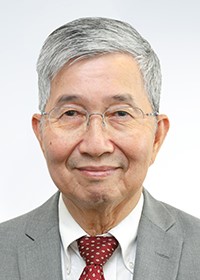2019 Kyoto Prize Awarded to Ching Tang

Pioneering Contributions to the Birth of High-Efficiency Organic Light-Emitting Diodes and Their Applications
Dr. Tang studied light emission processes in electrically-driven organic materials and invented a new device structure in which two carefully-selected materials were stacked, allowing for high-efficiency light emission at low drive voltages. This pioneering work has led to the practical use of organic light-emitting diodes (OLEDs) and their widespread application in displays and lighting.
In the 1950s, a group of organic materials were found to be semi-conductive and their electrical conductivities were found to increase significantly when dopants were added. It was then discovered in the 1960s that some organic materials emit light when a high voltage is applied across them. Though the discovery of this electroluminescence (EL) triggered much research work to develop organic EL devices, the emission efficiency remained low (about 0.1%), and the drive voltage required for EL remained high (several tens of volts); these problems hampered any practical application of EL. However, in 1987, Dr. Ching W. Tang invented a new EL device structure consisting of a stack of two carefully-selected organic molecular layers. He demonstrated that this structure facilitates an efficient flow of electric current that results in efficient light emission from the interface region between the two layers (1), even when the applied voltage is set as low as several volts. This innovation paved the way for the practical application of organic EL devices, also known as organic light emitting diodes (OLEDs).
Dr. Tang’s new device structure consists of an aromatic diamine hole transport layer, in which the holes carry the current, and an 8-hydroxyquinoline aluminum (Alq) electron transport layer, in which the current is carried by the electrons. When a voltage is applied across the device, holes are injected from the anode into the aromatic diamine layer, while electrons are injected from the cathode into the Alq layer. These electrons and holes recombine with each other resulting in light emission with an excellent efficiency in excess of 1%. Dr. Tang set the hole transport layer as thin as 75 nm and the electron transport layer as thin as 60 nm in order to reduce the electrical resistance of the device; it allowed the device to be driven by a voltage of less than 10 V. Moreover, the cathode on the Alq layer was made using a magnesium-silver alloy to ensure both efficient electron injection and chemical stability (1). To increase the light emission efficiency of OLEDs and to control the wavelength of the light they emit, Dr. Tang also invented a more advanced device structure in which a part of the Alq layer was doped with highly fluorescent molecules. By optimizing the position of the doped layer and its dopant concentration, he achieved a five-fold increase in the efficiency and spectral control of the emitted light (2).
These works accelerated the development of new materials and device structures for OLEDs, resulting in substantial improvements in their efficiency and reliability; they have enabled the practical application of OLEDs and led to their widespread use in displays and lighting.
Dr. Tang invented the basic structure of OLEDs to drastically raise their efficiency on the basis of academic studies on organic materials. His pioneering works have enabled the practical use of OLEDs and their applications and constitute a clearly outstanding contribution to the fields of materials science and electronics. Indeed, Dr. Tang is truly worthy of receiving the Kyoto Prize.
References
(1) Tang CW & Van Slyke SA (1987) Organic electroluminescent diodes. Applied Physics Letters51: 913–915.
(2) Tang CW et al. (1989) Electroluminescence of doped organic thin films. Journal of Applied Physics 65: 3610–3616.
